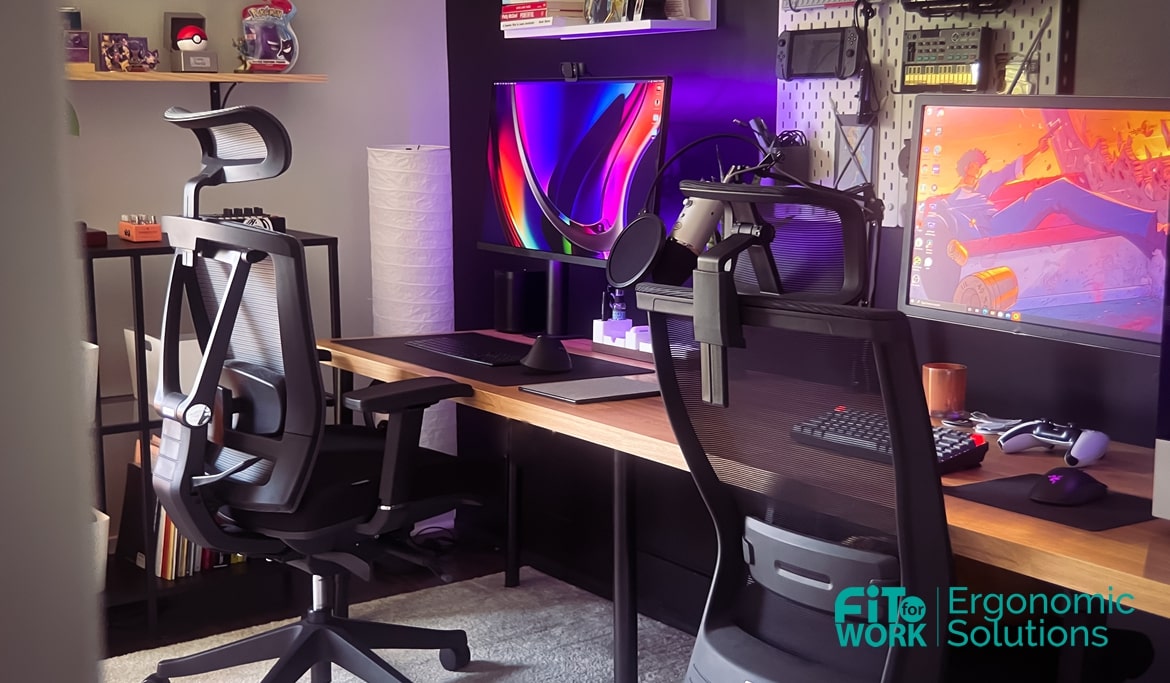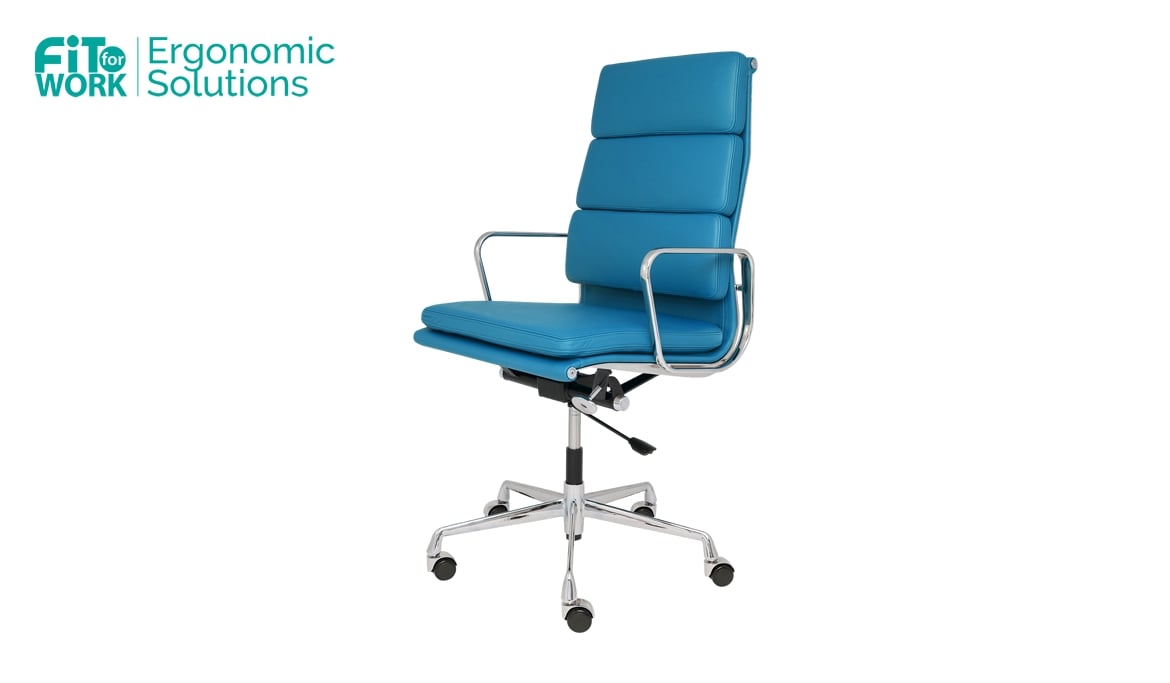Table of contents:
2. What is the meaning of an ergonomic chair
3. What makes a good ergonomic chair
4. Why are good ergonomic chairs important
5. Things you have to know in choosing an ergonomic chair
7. Ergonomic chair: a factor for productivity
Did you know that musculoskeletal diseases (MSDs) are the leading cause of disability worldwide? Many chairs in the workplace can contribute to the development of MSDs. These disorders affect the muscles, tendons, ligaments, nerves, and other soft tissues of the body, and they can cause pain, stiffness, numbness, and weakness in affected areas.
Do your employees use ergonomic office chairs? Using such chairs is vital in protecting them from MSDs. However, you should not purchase office chairs right away just because they claim to be ergonomic.
Read our article “What is ergonomics?” for more information about ergonomic principles.
It’s important to scrutinise what you see in the market and ask the experts for help. As you continue reading, you will learn more about ergonomic chairs. First, let’s discuss what an ergonomic chair is.
What is the meaning of an ergonomic chair
As stated by the Canadian Centre for Occupational Health and Safety (CCOHS), an ergonomic chair is tailored to a worker’s size (body measurements), workstation, and the duties that must be completed there. All of these must be considered when choosing which chair to use.
Typically, they marketed as “ergonomic chairs” are designed to fit a wide range of individuals as they have the adjustable features to meet the requirements of many users. There is no assurance that they will be suitable for any particular individual. For instance, a tall, plus-size worker might find a chair too short and the space between the armrests too narrow. Chairs might not be right for every job or set up at the desk.
You also need to know what are NOT ergonomic chairs. A non-ergonomic one has a sub-optimal design that causes musculoskeletal dysfunctions. It lacks the following:
- Height and backrest adjusters
- Curves that support the spine
- High backrest
- Lockable backrest
- Lumbar support
In 1992, there was a report of an increasing number of office equipment suppliers selling products with exaggerated and sometimes deceptive claims about their beneficial effects. Back then, the term “ergonomic” was often affixed to a piece of equipment without any supporting evidence. There was hardly any testing done on products to determine if they would function properly or ergonomically.
Now that there are government units that mandate occupational safety, like the Occupational Safety and Health Administration (OSHA) and CCOHS, you can get as much information as you need. There is no excuse for failing to check on the equipment you purchase for your company.
You can also learn more about ergonomic risk management through the help of ergonomic specialists. So what makes an office chair ergonomic? We will discuss the features of an ergonomic chair one by one, but here’s a general idea: an office chair should be well-designed and adjustable to be considered ergonomic. It should give the back, legs, knees, and arms the support they need and reduces the risk of awkward positions, contact stress, and forceful work.
What makes a good ergonomic chair
You might ask, “Do ergonomic chairs work?”
The answer could be yes or no. Yes, if you get the ones with the good features. And no, if you purchased the ones pretending to be ergonomic.
There are plenty of good ergonomic chairs in the market. But always remember that they could be false claims. Also, some chairs look sophisticated but don’t offer qualified ergonomic features. In other words, they are not worker-friendly.
Here are the features of a good ergonomic chair:
Adjustability
Chiropractor Dr. Rodney K. Lefler says it’s essential to adjust the proportions of the individual’s body to the workplace chair in order to enhance comfort and minimise aggravation to the spine.

After the employee has arranged the workstation to their comfort, they can change the height of their workplace chair to correspond with their body type.
Here is a quick list of the essential chair adjustability you should test before buying to ensure it’s as comfy as possible and puts the least stress on the back.
1. Elbow measure
You should be able to raise or lower the chair to position your elbow at a 90-degree angle so that the hands are floating above the keyboard. The elbow and wrist should also be in a straight line parallel to the floor.
2. Low back / lumbar support
You should be able to sit your bottom all the way back in the chair and put your back against its back. There should be a lumbar support to support the natural curve of your spine.
3. Thigh support
Ensure you can slip 2-3 fingers between the front of the cushion and back of your knees. It should not be too tight, nor should the space be too much.
4. Armrest
You should only use arm rests if you can touch the arm rests with your elbows in by your side at a 90 degree angle. If you have to flair out your arms or hunch up your shoulders to use the armrest, you should not use them.
Range of the seat height
Dr. Lefler recommends that the chair should have height adjustability. This lets the person use the desk with their feet flat on the floor, their legs flat, and their arms at the same height as the desk.
Check if the seat height can be changed to fit the worker who will use it. Very short or tall workers might need to sit in a different chair. A person should be able to sit with their feet on the floor or a footrest without feeling pressure on the underside of their legs.
Backrest
It should be adjustable upward, downward, and even forward and backward. The spine support should be strong, but there shouldn’t be any pressure points that stop blood from flowing. The seat should be the right height and width to support you without making it hard to move around.
Poor back support and posture can come from improper backrest height, material, location, or use. These positions may cause back pain and fatigue. A chair without a sufficient or adjustable backrest won’t support the spine’s natural S-curve.

Depth of the seat
Select the ones that suit the shortest and the tallest employers. They need to be able to sit in the chair while not experiencing any discomfort in the region behind their knees, with the backrest providing support for their spine. The support should be felt on the buttocks and thighs. Seat depth should be adjusted so that there are between two and four fingers of space between the knees’ back and the front edge of the seat.
Consider your employees’ anthropometrics (the comparative study of body measurements) while checking the seat pan depth. A mismatch in size compromises the body’s postural muscles and strains the neuromuscular system, causing pain.
Width of the seat
It should be wide enough to provide users with comfortable, uniform pressure across the entire seat and to permit posture adjustments. The usual ergonomic width is often between 17 and 20 inches.
A seat pan’s width should be more than the hips’ width while sitting. It should allow users to effortlessly enter and leave the chair and distribute their weight evenly on the seat while allowing for mobility. A too-small one might limit mobility and provide insufficient support. Long-term usage might reduce blood flow to the legs, causing discomfort and soreness. Then, chairs with extra-large seat pans should be available for larger employees.
Armrests
Armrests should give support and distribute it equally across the arms. Their height and width should be adjustable. In other cases, armrests may be ineffective because they restrict a person from sitting near enough to the desk and keyboard. The chair you will choose should have armrests that can be removed and adjusted.
Here are the common armrest flaws:
Too wide
Requires elbow support and bending forward, which strains shoulders and neck.
Too close
Makes it difficult for workers to get in and out of the chair.
Too low
Forces them to rest one forearm, leading to strained neck, shoulders, and back.
Too high
Produces elevated shoulders, causing neck and shoulder muscular stress and fatigue
Too wide
Interferes with chair placement, which could force workers to reach and lean forward if the chair is too far from the desk; tires the lower back, arm, and shoulder.
Made of hard and/or sharp materials
Irritates forearm nerves and blood vessels, leading to inflammation that can cause finger, hand, and arm discomfort or tingling.

Seat surface
The surface of the seat should be soft and generally made of materials that let air pass through and prevent heat and moisture from building up. Specific materials may be more suitable in some places of work, like hospitals or labs, where preventing infections is important.
Stability
A sturdy base for a chair should consist of five legs, and it should also include casters so that it can be easily moved around the floor. Chairs with four or fewer legs may be unsupportive and prone to tipping.

If the chair’s casters aren’t the right size or shape, or if it doesn’t have them at all, it can be hard to move the chair around the desk. This makes it harder to reach and bend down to get the workstation items, which can cause muscle pain and tiredness.
Why are good ergonomic chairs important
If you work at a desk for a substantial portion of the day, you already know how vital it is to have a chair that is both comfortable and supportive. But can having a chair designed to fit your body really make a difference? The simple answer is yes. And your employees need it to efficiently fulfil the tasks they need to do while sitting for a long time.
According to CCOHS, injuries caused by prolonged sitting are a severe workplace health and safety issue. Professions that involve long-time sitting require a less muscular effort but expose workers to the same injury risks as more physically demanding tasks. In fact, workers who sit more often than those who do harder work report more varicose veins, stiff necks, and tingling in their legs.
Since office employees can’t move around much when they’re sitting, their circulation system doesn’t have to work as hard. Because of this, blood flow slows down. Do you observe some of your employees looking more tired even if they’re only sitting? Well, the decreased blood flow explains why they feel exhausted.
This is where the ergonomic chair works. According to studies, people felt less pain or soreness in their muscles and joints after an intervention of ergonomic chairs. The research results show that an ergonomic chair remedy can help lower the degree, intensity, and frequency of musculoskeletal pain in workers who have to sit for an extended amount of time.
Read our article “Ergonomics for back pain prevention: sitting and standing at work” for more information about back pain in workers.
Good ergonomic chairs are essential for your employees because they help them avoid body pains and musculoskeletal disorders in the long run. When your employees comfortably sit while working, they become more productive, happy, and vibrant. You will also increase your employee retention rate.
Things you have to know in choosing an ergonomic chair
CCOHS states that the ergonomics approach views sitting as a particular, specialised activity determined by how a sitting person interacts with the working environment.
Hence, when choosing the ergonomic chairs for your employees, here are the things you should consider:
- One chair does not fit everyone. When selecting one, your employees’ body dimensions must be considered so that the chair does not strain one part of the body while fitting another.
- Gather information on their body height. The ideal seat height is one-quarter of one’s body height. Because the torso-to-leg ratio varies greatly, this approximation is merely a rule of thumb.
- No chair works for EVERY activity. Your maintenance employees, office employees, and company nurses may need distinct chairs.
- Always consider repair and maintenance expenses. Consult the manufacturer for inspection of items and how often they would conduct it.
Now, to assess the ergonomic chairs before purchase, you can always refer to the ergonomic chair guide to make sure you won’t waste your funds.
Ergonomic chair checklist
Here are some points from the checklist provided by OSHA to guide you on how to select an ergonomic office chair:
- The chair should be easy to adjust.
- The chair should have a strong base with five legs and wheels that roll easily over the floor or rugs.
- The chair should be able to turn all the way around, so you don’t have to twist to get to things around your desk.
- The seat pan width should match the employees’ thighs. The minimum width should be 17 inches.
- The seat pan’s front edge should be shaped like a waterfall.
- The seat pan material should be breathable, firm, and resilient.
- The adjustable lumbar support should fit the lower back curve. The backrest should be 17.7 inches above the compacted seat pan and 14.2 inches wide.
- Removable armrests with adjustable spacing are needed.
- Armrests should support forearms without blocking the work surface.
- Most chairs are intended for people weighing less than 275 pounds. If the user weighs more than 275 pounds, the chair must be designed to accommodate the additional weight.
Always remember that when you choose ergonomic chairs, you should consider employees of every size and height.
Ergonomic chair: a factor for productivity
Now that you have learned many things about a good ergonomic chair, you can look forward to purchasing the right one for your employees. You can also expect them to be more productive and happy at work.
You just have to remember an ergonomic chair’s essential features (i.e., adjustability, seat height range, backrest, seat depth, seat width, seat surface, and stability), the things to consider while you’re choosing which ergonomic chairs to buy, and the checklist.
With the new chairs, you and your employees will be trained on how to use them. However, it is better to have your workstations assessed to make sure all is optimised.
Your employees are valuable company assets because they bring skills and knowledge to the organisation that are essential for performing various tasks and achieving business objectives. Hence, they deserve good ergonomic chairs. You can always consult us about an ergonomic evaluation if you want more expert advice.
Don’t wait too long before your employees experience terrible discomfort. Contact us to start implementing the much-needed ergonomics at your workplace.



